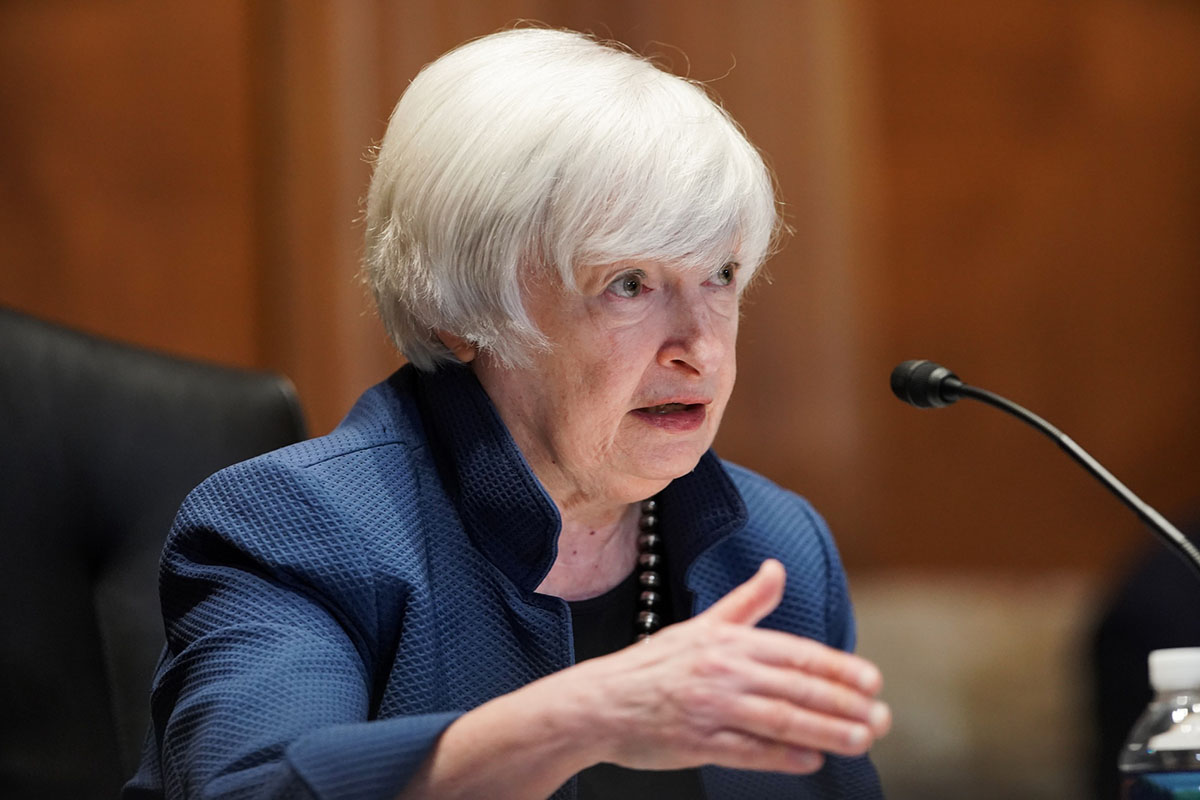

Finance
What Is Treasury Market Liquidity?
Published: February 23, 2024
Learn about the importance of liquidity in the finance sector with an overview of the treasury market. Understand the dynamics and implications of treasury market liquidity.
(Many of the links in this article redirect to a specific reviewed product. Your purchase of these products through affiliate links helps to generate commission for LiveWell, at no extra cost. Learn more)
Table of Contents
**
Introduction
**
The Treasury market is a vital component of the global financial system, serving as a platform for the issuance and trading of government securities. Treasury market liquidity plays a crucial role in ensuring the smooth functioning of this market. In simple terms, liquidity refers to the ease with which assets can be bought or sold without causing a significant change in their price. In the context of the Treasury market, liquidity is essential for maintaining stability and efficiency in the trading of government securities.
The concept of liquidity is of paramount importance in the financial world, as it directly impacts the cost and ease of executing trades. In the context of the Treasury market, it is particularly significant due to the pivotal role of government securities in the broader economy. These securities are considered a benchmark for pricing various financial instruments and serve as a safe haven for investors during times of market volatility. As such, the liquidity of the Treasury market has far-reaching implications for the overall stability of the financial system.
Understanding the dynamics of Treasury market liquidity is essential for market participants, policymakers, and investors. This article delves into the intricacies of Treasury market liquidity, exploring the factors that influence it, its significance, and the measures used to assess it. By gaining insights into these aspects, stakeholders can make informed decisions and navigate the Treasury market more effectively. Let's embark on a journey to unravel the nuances of Treasury market liquidity and its pivotal role in the broader financial landscape.
**
Understanding Liquidity in the Treasury Market
**
Liquidity in the Treasury market refers to the ease with which Treasury securities can be bought or sold in the market without significantly impacting their prices. It is a measure of the market’s ability to accommodate large transactions with minimal impact on the prevailing prices. Understanding liquidity in the Treasury market entails grasping the factors that contribute to it, as well as the dynamics that shape its ebbs and flows.
The liquidity of Treasury securities is influenced by various factors, including the volume of outstanding securities, market depth, and the presence of active buyers and sellers. The volume of outstanding securities, particularly in benchmark issues such as the 10-year and 30-year Treasury bonds, plays a crucial role in determining market liquidity. A higher volume of outstanding securities often translates to greater liquidity, as there are more securities available for trading, thereby facilitating smoother transactions.
Market depth, which refers to the availability of buy and sell orders at various price levels, also impacts Treasury market liquidity. A deep market with a substantial number of active buyers and sellers contributes to greater liquidity, as there is a higher probability of matching buy and sell orders without causing significant price movements. Conversely, a shallow market with limited participation can lead to reduced liquidity, making it challenging to execute large trades without affecting prices.
Moreover, the presence of market makers and institutional investors significantly influences Treasury market liquidity. Market makers play a pivotal role in facilitating trading by providing continuous buy and sell quotes for Treasury securities. Their presence enhances market liquidity by ensuring that there are always counterparties available for executing trades. Similarly, the participation of institutional investors, such as pension funds and mutual funds, contributes to market liquidity, as these entities are often involved in large-scale transactions that drive market activity.
Understanding liquidity in the Treasury market is essential for market participants, as it enables them to gauge the ease of executing trades and assess the potential impact on prices. By comprehending the underlying factors that shape liquidity, investors and traders can make more informed decisions and navigate the market with greater confidence.
**
Factors Affecting Treasury Market Liquidity
**
The liquidity of the Treasury market is influenced by a myriad of factors that collectively shape the ease and efficiency of trading Treasury securities. Understanding these factors is crucial for market participants, as they directly impact the dynamics of the market and the execution of trades.
1. Market Conditions: Market conditions, including overall economic stability, interest rate movements, and investor sentiment, significantly affect Treasury market liquidity. During periods of economic uncertainty or heightened market volatility, liquidity may diminish as investors become more risk-averse, leading to reduced trading activity and potentially wider bid-ask spreads.
2. Regulatory Environment: Regulatory changes and interventions can have a profound impact on Treasury market liquidity. For instance, regulatory reforms aimed at enhancing market transparency and reducing systemic risk may influence the behavior of market participants and the overall liquidity landscape.
3. Market Participants: The presence and behavior of market participants, such as institutional investors, hedge funds, and high-frequency traders, play a pivotal role in shaping Treasury market liquidity. The trading strategies and activity of these participants can impact market depth and the availability of counterparties for executing trades.
4. Government Debt Issuance: The volume and frequency of government debt issuance directly affect Treasury market liquidity. Increased issuance of Treasury securities can potentially strain market liquidity, especially if the supply outpaces demand, leading to adjustments in prices and trading dynamics.
5. Monetary Policy: The actions and communication of central banks, particularly the Federal Reserve, have profound implications for Treasury market liquidity. Changes in monetary policy, including interest rate decisions and quantitative easing measures, can influence investor behavior and market liquidity.
6. Technology and Trading Infrastructure: Advancements in trading technology and the evolution of trading platforms have transformed the landscape of Treasury market liquidity. Electronic trading, algorithmic execution, and high-speed connectivity have reshaped the speed and efficiency of trading, impacting market liquidity dynamics.
7. Global Market Interconnections: The interconnectedness of global financial markets can transmit liquidity shocks across borders, affecting the liquidity of the Treasury market. Events in international markets and cross-border capital flows can influence the availability of liquidity in the Treasury market.
By comprehending the multifaceted factors that affect Treasury market liquidity, market participants can adapt their strategies and risk management approaches to navigate the market more effectively. Monitoring these factors and their evolving dynamics is essential for staying attuned to the ever-changing landscape of Treasury market liquidity.
**
Importance of Treasury Market Liquidity
**
The liquidity of the Treasury market holds immense significance for various stakeholders, encompassing investors, financial institutions, policymakers, and the broader economy. Recognizing the importance of Treasury market liquidity sheds light on its far-reaching implications and underscores its pivotal role in the functioning of the financial system.
1. Efficient Capital Markets: Treasury market liquidity is essential for maintaining efficient capital markets. It enables investors to buy and sell Treasury securities with ease, ensuring that capital can be allocated and reallocated efficiently based on changing investment objectives and market conditions.
2. Risk Management: Liquidity in the Treasury market is integral to effective risk management for investors and financial institutions. The ability to execute trades promptly and at fair prices enhances the capacity to adjust investment portfolios and hedge against market risks, contributing to overall financial stability.
3. Benchmark Pricing: Treasury securities serve as benchmark assets for pricing various financial instruments, including corporate bonds, mortgages, and derivatives. Adequate liquidity in the Treasury market is crucial for accurate price discovery and valuation across a spectrum of financial products, thereby underpinning the integrity of broader financial markets.
4. Monetary Policy Transmission: The liquidity of the Treasury market plays a vital role in the transmission of monetary policy. The Federal Reserve utilizes open market operations to influence interest rates and overall financial conditions, and the effectiveness of these operations hinges on the liquidity and functionality of the Treasury market.
5. Investor Confidence and Stability: A liquid Treasury market fosters investor confidence and market stability. The availability of liquidity instills trust in the market’s ability to absorb large trades without significant price disruptions, thereby contributing to a more stable and resilient financial system.
6. Government Funding Costs: Liquidity in the Treasury market directly impacts the borrowing costs of the government. A liquid market allows for the efficient issuance of government debt, ensuring that funding needs can be met at favorable terms, ultimately influencing fiscal management and public finances.
7. Market Integrity and Resilience: The liquidity of the Treasury market is intertwined with market integrity and resilience. Adequate liquidity safeguards against disorderly market conditions and enhances the market’s ability to absorb shocks, thereby bolstering its overall resilience.
The importance of Treasury market liquidity extends beyond the realm of financial markets, permeating the broader economic landscape. It serves as a cornerstone of financial stability, efficient capital allocation, and effective monetary policy transmission, underscoring its indispensable role in sustaining a robust and well-functioning financial system.
**
Measures of Treasury Market Liquidity
**
Assessing the liquidity of the Treasury market involves employing various measures and indicators that provide insights into the market’s depth, resilience, and efficiency. These measures serve as valuable tools for market participants, regulators, and policymakers, offering a comprehensive view of liquidity dynamics and facilitating informed decision-making.
1. Bid-Ask Spread: The bid-ask spread, representing the difference between the highest price a buyer is willing to pay and the lowest price a seller is willing to accept, serves as a fundamental indicator of Treasury market liquidity. A narrower spread typically signifies higher liquidity, as it indicates lower trading costs and greater ease of executing trades.
2. Volume and Turnover: Monitoring trading volume and turnover in the Treasury market provides insights into liquidity dynamics. Higher trading volumes and turnover often indicate robust liquidity, reflecting active participation and the ability to readily buy or sell securities without significantly impacting prices.
3. Market Depth: Assessing market depth involves examining the availability of buy and sell orders at various price levels. A deep market, characterized by a substantial number of orders at different price points, suggests greater liquidity, as there is ample liquidity to absorb large trades without causing substantial price movements.
4. Price Impact of Trades: Analyzing the price impact of trades, particularly large transactions, offers valuable insights into liquidity. A minimal price impact indicates ample liquidity, as large trades can be executed without substantially affecting market prices, while a significant price impact may signal lower liquidity.
5. Transaction Costs: Evaluating transaction costs, including brokerage fees and market impact costs, provides a practical gauge of liquidity. Lower transaction costs typically align with higher liquidity, as they reflect the ease and efficiency of executing trades in the Treasury market.
6. Market Resilience: Assessing the market’s resilience to stress events and sudden liquidity shocks is integral to understanding Treasury market liquidity. The ability of the market to absorb and recover from adverse liquidity conditions underscores its overall robustness and liquidity profile.
7. Market-Making Activity: Monitoring the activity of market makers and the provision of continuous buy and sell quotes for Treasury securities offers insights into market liquidity. Active market-making activity contributes to enhanced liquidity by ensuring the availability of counterparties for executing trades.
By leveraging these measures and indicators, market participants can gain a comprehensive understanding of Treasury market liquidity, enabling them to make informed decisions, manage risks effectively, and navigate the market with confidence. Additionally, regulators and policymakers can utilize these measures to assess market conditions and implement targeted interventions to preserve and enhance market liquidity.
**
Conclusion
**
The liquidity of the Treasury market stands as a cornerstone of the global financial system, underpinning efficient capital markets, effective risk management, and the transmission of monetary policy. Understanding and monitoring Treasury market liquidity is paramount for market participants, policymakers, and investors, as it directly influences trading dynamics, market resilience, and the broader economic landscape.
By delving into the intricacies of Treasury market liquidity, we have unveiled its multifaceted nature, encompassing factors such as market conditions, regulatory environment, and the interplay of market participants. The significance of Treasury market liquidity extends beyond the realm of financial markets, permeating the broader economy and serving as a linchpin for market integrity, stability, and efficient capital allocation.
Measures of Treasury market liquidity, including bid-ask spreads, trading volume, market depth, and transaction costs, offer valuable insights into the liquidity landscape, empowering stakeholders to gauge market conditions and make well-informed decisions. These measures serve as indispensable tools for assessing liquidity dynamics, identifying potential risks, and preserving the resilience of the Treasury market.
As the financial landscape continues to evolve, the importance of Treasury market liquidity remains steadfast, guiding market participants in navigating changing market conditions and fostering a robust and resilient financial system. By recognizing the pivotal role of Treasury market liquidity and embracing a nuanced understanding of its intricacies, stakeholders can adapt to evolving market dynamics and contribute to the sustainability and efficiency of the Treasury market.
In conclusion, Treasury market liquidity serves as a linchpin of the broader financial ecosystem, shaping market dynamics, investor confidence, and the effectiveness of monetary policy. Embracing a holistic comprehension of Treasury market liquidity empowers stakeholders to navigate the market with confidence, foster market resilience, and contribute to the stability and efficiency of the global financial system.














